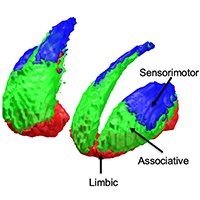Striatal topographical organization: Bridging the gap between molecules, connectivity and behavior

Accepted: 7 September 2021
HTML: 16
All claims expressed in this article are solely those of the authors and do not necessarily represent those of their affiliated organizations, or those of the publisher, the editors and the reviewers. Any product that may be evaluated in this article or claim that may be made by its manufacturer is not guaranteed or endorsed by the publisher.
Authors
The striatum represents the major hub of the basal ganglia, receiving projections from the entire cerebral cortex and it is assumed to play a key role in a wide array of complex behavioral tasks. Despite being extensively investigated during the last decades, the topographical organization of the striatum is not well understood yet. Ongoing efforts in neuroscience are focused on analyzing striatal anatomy at different spatial scales, to understand how structure relates to function and how derangements of this organization are involved in various neuropsychiatric diseases. While being subdivided at the macroscale level into dorsal and ventral divisions, at a mesoscale level the striatum represents an anatomical continuum sharing the same cellular makeup. At the same time, it is now increasingly ascertained that different striatal compartments show subtle histochemical differences, and their neurons exhibit peculiar patterns of gene expression, supporting functional diversity across the whole basal ganglia circuitry. Such diversity is further supported by afferent connections which are heterogenous both anatomically, as they originate from distributed cortical areas and subcortical structures, and biochemically, as they involve a variety of neurotransmitters. Specifically, the cortico-striatal projection system is topographically organized delineating a functional organization which is maintained throughout the basal ganglia, subserving motor, cognitive and affective behavioral functions. While such functional heterogeneity has been firstly conceptualized as a tripartite organization, with sharply defined limbic, associative and sensorimotor territories within the striatum, it has been proposed that such territories are more likely to fade into one another, delineating a gradient-like organization along medio-lateral and ventro-dorsal axes. However, the molecular and cellular underpinnings of such organization are less understood, and their relations to behavior remains an open question, especially in humans. In this review we aimed at summarizing the available knowledge on striatal organization, especially focusing on how it links structure to function and its alterations in neuropsychiatric diseases. We examined studies conducted on different species, covering a wide array of different methodologies: from tract-tracing and immunohistochemistry to neuroimaging and transcriptomic experiments, aimed at bridging the gap between macroscopic and molecular levels.
How to Cite

This work is licensed under a Creative Commons Attribution-NonCommercial 4.0 International License.
PAGEPress has chosen to apply the Creative Commons Attribution NonCommercial 4.0 International License (CC BY-NC 4.0) to all manuscripts to be published.
Similar Articles
- V. Bertone, E. Tarantola, A. Ferrigno, E. Gringeri, S. Barni, M. Vairetti, I. Freitas, Altered alkaline phosphatase activity in obese Zucker rats liver respect to lean Zucker and Wistar rats discussed in terms of all putative roles ascribed to the enzyme , European Journal of Histochemistry: Vol. 55 No. 1 (2011)
- G. Di Guardo, Lipofuscin, lipofuscin-like pigments and autofluorescence , European Journal of Histochemistry: Vol. 59 No. 1 (2015)
- H. Zhang, P. Liu, S. Wang, C. Liu, P. Jani, Y. Lu, C. Qin, Transgenic expression of dentin phosphoprotein inhibits skeletal development , European Journal of Histochemistry: Vol. 60 No. 1 (2016)
- Andreea Cioca, Amalia R. Ceausu, Irina Marin, Marius Raica, Anca M. Cimpean, The multifaceted role of podoplanin expression in hepatocellular carcinoma , European Journal of Histochemistry: Vol. 61 No. 1 (2017)
- D Fanni, L Pilloni, S Orrù, P Coni, Expression of ATP7B in normal human liver , European Journal of Histochemistry: Vol. 49 No. 4 (2005)
- M. Acosta, V. Filippa, F. Mohamed, Folliculostellate cells in pituitary pars distalis of male viscacha: immunohistochemical, morphometric and ultrastructural study , European Journal of Histochemistry: Vol. 54 No. 1 (2010)
- J. Pelz, W. Härtig, C. Weise, C. Hobohm, D. Schneider, M. Krueger, J. Kacza, D. Michalski, Endothelial barrier antigen-immunoreactivity is conversely associated with blood-brain barrier dysfunction after embolic stroke in rats , European Journal of Histochemistry: Vol. 57 No. 4 (2013)
- C. Fede, G. Albertin, L. Petrelli, M.M. Sfriso, C. Biz, R. De Caro, C. Stecco, Expression of the endocannabinoid receptors in human fascial tissue , European Journal of Histochemistry: Vol. 60 No. 2 (2016)
- Jana Oswald, Maximilian Büttner, Simon Jasinski-Bergner, Roland Jacobs, Philip Rosenstock, Heike Kielstein, Leptin affects filopodia and cofilin in NK-92 cells in a dose- and time-dependent manner , European Journal of Histochemistry: Vol. 62 No. 1 (2018)
- Flavia Carton, The contribution of immunohistochemistry to the development of hydrogels for skin repair and regeneration , European Journal of Histochemistry: Vol. 67 No. 1 (2023)
<< < 10 11 12 13 14 15 16 17 18 19 > >>
You may also start an advanced similarity search for this article.

 https://doi.org/10.4081/ejh.2021.3284
https://doi.org/10.4081/ejh.2021.3284










